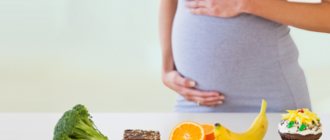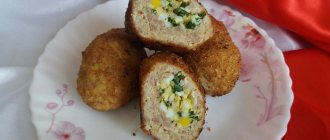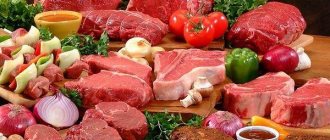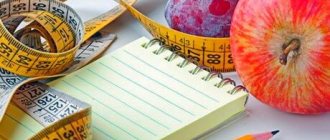Cutting is getting rid of fat through a low-carb diet and exercise. This concept was introduced into everyday use by bodybuilders who needed to demonstrate muscle definition in order to perform in competitions. The methods of drying are different for men and girls, as are the methods of training to remove fat.
What is a no-carb diet
A low-calorie diet without carbohydrates and with a minimum of fat causes rapid weight loss and “dries out” the body without damaging the muscles. The effectiveness of the diet has been confirmed by its popularity among professional athletes and bodybuilders.

Carbohydrates provide the body with energy. If a person moves little and the food is oversaturated with carbohydrate foods, the balance is disrupted. Carbohydrates simply do not have time to be spent and turn into fat.
If you significantly reduce your carbohydrate intake, the reverse process will begin. A lack of calories will force the body to look for other sources of energy. First it will slow down the metabolic processes, then it will try to use the muscles. That’s why physical activity is needed: to strengthen muscle mass. The body uses up the glycogen stored in the liver for several days. And only then does subcutaneous fat become fuel.
To prevent inhibition of metabolic processes, meals should be fractional, at least 6 times a day.
Eating even complex carbohydrates provokes the release of insulin: an anabolic hormone that affects fat tissue. The purpose of insulin is to reduce the concentration of sugar in the blood by distributing excess sugar. With excess volumes, it replenishes glycogen reserves and synthesizes fat. When the amount of carbohydrates in food is minimal, the secretion of the hormone decreases and it is not able to prevent fat burning.
The body drying menu is rich in proteins and contains a minimum of complex carbohydrates. A special diet that burns fat has no set duration. The duration depends on how you feel, on average it lasts 2-6 weeks.
In order not to feel a lack of energy and loss of strength, to avoid exhaustion and intoxication, you need the right diet. It is better to compile it in the company of a nutritionist.
Basic Rules
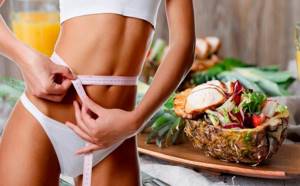
A balanced menu and adequate diet will allow you to stay on a low-carbohydrate diet for a long time, maintain health and achieve ideal shape:
- The daily diet includes no more than 40 g of carbohydrates for a strict diet, and no more than 125 g for a gentle option. The main suppliers are vegetables and herbs. In addition to fiber, you need to take into account the carbohydrate error of protein nutrition. The carbohydrate diet is reduced gradually.
- The menu has a sufficient amount of protein: 2.5-3 g/kg body weight. This ideal ratio will preserve muscle tissue. It is believed that it is better to consume more protein than to become deficient.
- You need to drink a lot of water. The restriction is practiced only by professional athletes under the supervision of a doctor. To improve metabolism and remove breakdown products, the volume of clean water should be 1 l/30 kg of weight.
- Nutritionists suggest periodically enriching water with mineral salts of the drug Regidron with a dosage reduced by 3 times.
- Eating fat (at least 0.5 g/kg body weight) will support the functionality of the hormonal system and the condition of hair, nails and skin. To get the required amount of fatty acids, you need fish, oil and nuts.
- Meals should be frequent and portions should be small. The most important meal of the day is breakfast. It is better to make dinner completely protein. Skipping meals is not recommended: it can disrupt your metabolic rate.
- There is almost no salt in the diet.
- During the diet, you need to take complex vitamin preparations with microelements.
- Daily exercise is necessary. The best choice is a combination of strength training and cardio exercises.
- One hour before training and 2 hours after it, eating is excluded.
This is interesting: Protasov’s diet: detailed description
Why do you need to give up carbohydrates?

There is an opinion that during drying it is necessary to completely eliminate carbohydrates and give preference exclusively to protein nutrition. In fact, for a highly effective result, you need to reasonably limit carbohydrates, or rather, minimize them (low-carbohydrate diet), but in no case give them up completely. This is due to the fact that carbohydrates are a source of energy; their intake increases endurance and performance. For those who think this theory is wrong, you can conduct a small experiment. Try eating exclusively protein for a few days. As a result, you will notice how quickly fatigue sets in during training, energy and strength disappear, drowsiness appears and decreased performance.
It is enough to completely give up simple carbohydrates, which do not provide any benefits for health or weight loss. Once you exclude them, the body will have nowhere to take energy from; it will have to use existing reserves in the form of fat deposits.
Pros and cons of a no-carb diet
A no-carbohydrate diet is not a balanced one. Moreover, it is considered one of the extreme. Nutritionists do not recommend using “drying” more than twice a year. Not everyone is able to withstand a strict diet combined with mandatory training.

Only self-discipline, motivation and attitude will bring success in working on an ideal body.
In the first days of carbohydrate restriction, weakness, apathy and decreased ability to work will appear. Then the body will get used to the new conditions, and unpleasant sensations will be less frequent. In the final stages, the smell of acetone may appear on your breath. This is a companion to all protein diets. Periodic dizziness due to acute carbohydrate deficiency can be relieved by taking a small amount of natural fruit juices.
Protein-rich foods provoke an exacerbation of chronic problems, the liver and kidneys suffer. Lack of fiber causes disruption of the gastrointestinal tract: heaviness and constipation appear. The brain senses a glucose deficiency. This manifests itself in a clear decrease in thought processes, loss of attention and concentration. A person may experience constant irritation and even become depressed.
The undoubted advantages of a low-carbohydrate diet for weight loss include:
- lack of feeling of hunger;
- fast pace of weight loss;
- long lasting effectiveness.
What varieties are there?
The diet has two options.
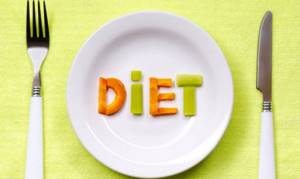
The optimal one is chosen taking into account health capabilities and the expected result:
- Gentle. The menu reduces the carbohydrate part to 125 g/day. The diet is easy to tolerate, but weight loss is slow.
- Strict. The mass of carbohydrates is strictly limited to 20-40 g per day. Gives quick and impressive results. Used under the supervision of a nutritionist according to an individual diet, selected taking into account the characteristics of the body.
The principles of carbohydrate-free nutrition are also used in other protein diets - Dukan, Kremlin, Montignac, keto diet.
Recommended and prohibited products
Diet developers recommend keeping track of carbohydrates and calories consumed. This makes it easier to meet the daily requirement and get closer to the desired result faster.

The basis of the diet is dietary poultry or rabbit meat, low-calorie fish (cod, pollock, pink salmon) and seafood. Fermented milk products are allowed: low-fat kefir and natural yogurt. Lean pork, veal or beef is allowed in small quantities. It is better to get at least 85% of the required volume of carbohydrates from fresh or thermally processed vegetables and fruits.
Recommended protein sources (basis of diet):
- Product No. 1 of a low-carbohydrate diet is boiled chicken (quail) eggs. It is better to eat whites and limit yolks to two per day.
- Boiled chicken (turkey) breast. The product is practically free of fat and carbohydrates, containing a lot of protein.
- Skim cheese. A source of valuable protein (casein), which within 8-10 hours evenly supplies “building material” to the muscles and prevents their destruction.
- Fish. Protein source of Omega-3 fatty acids necessary for normal hormone levels, maintaining healthy skin, hair and nails.
Recommended carbohydrates:
- Vegetables with a lot of fiber: cabbage of all varieties, cucumbers, zucchini, tomatoes, spinach. These vitamin and mineral providers contain almost no carbohydrates or calories. Indispensable for metabolism, normal bowel function and improved overall cleansing.
- Grapefruits. Accelerate metabolism, burn fat, supply antioxidants.
- Kiwi, lemons, green apples.
- Greens: parsley, cilantro, dill, arugula and others. This is almost pure fiber. It has a mild diuretic effect on the body, which will bring the desired relief closer.
- Whole grain porridges rich in fiber: buckwheat, pearl barley and brown rice. A small amount of cereals with slow carbohydrates will saturate the body and normalize the functioning of the gastrointestinal tract.
Recommended sources of fatty acids:
- Fish (fish) oil. It is a supplier of omega-3 fats, essential for calorie deficits. Ensures the synthesis of hormones and the fight against “bad” cholesterol. It is recommended to obtain fat from lean fish and special preparations from pharmacies or sports nutrition stores.
- Vegetable fats, especially flaxseed and olive oil. Contains omega-3, 6 and 9 fatty acids. They have a positive effect on joints and ligaments and prevent injuries.
- Walnut. Contains essential fats and iodine for hormone synthesis and thyroid health.
- Avocado. Leader in concentration of monounsaturated fats and oleic acid (omega-9). Will enrich the taste of any salad.
For the best effect and increase in muscle mass, it is allowed to take protein sports nutrition.
Almost all fruits (except for those mentioned), alcohol, sweet drinks, juices, smoked foods, canned food, marinades, fast food, and baked goods are prohibited.
In the first two weeks of the diet, carbohydrate requirements are calculated as 2 g per 1 kg of body weight. Then the ratio is halved.
What foods should you avoid on this diet?
Let us remind you that even when drying, we exclude only fast carbohydrates and minimize the consumption of complex ones. On average, your daily diet should contain about 30 grams of complex carbohydrates. To understand what 30 grams of carbohydrates are, consider the table:
| Product | Amount of carbohydrates per 100 grams |
| Cottage cheese | 2 grams |
| Apple | 5 grams |
| Bread | 50 grams |
| Cucumber | 10 grams |
| Oat groats | 56 grams |
| Milk chocolate | 59 grams |
| Egg | 3 grams |
We can conclude that the maximum amount of carbohydrates is contained in sweet and flour products, for this reason, first of all, you need to give up them. Significantly lower amounts of carbohydrates are observed in chicken eggs and cottage cheese. It is worth noting that fish and dietary meat do not contain carbohydrates at all. Vegetables and fruits contain minimal amounts of carbohydrates.
When following a low-carbohydrate diet, it is recommended to avoid certain types of foods that contribute to the growth of subcutaneous fat. In addition to the ban on sweets and flour, the following should be excluded:
- Any drinks that contain alcohol.
- Products containing excessive starch content. These include not only potatoes, but also corn and legumes.
- Dairy products that contain questionable substances. These include flavoring additives and artificial colors.
- You should not buy ready-made meals. When preparing them, various sauces and flavor enhancers are often added, which are strictly prohibited on a carbohydrate-free diet.
Before you buy any food, be sure to read the ingredients on the package. Try to avoid unnatural products. Various trans fats and chemical additives are harmful not only to the drying process, but also to health.
Table of carbohydrate content in foods

Knowing how many carbohydrates you can, your daily intake can be easily controlled using the table.
| Products | Carbohydrate content: g/100 g product |
| Vegetables and greens | |
| Daikon (a type of radish) | 1,2 |
| Cucumbers from a greenhouse | 1,6 |
| Cucumbers grown in soil | 2,8 |
| Tomatoes (greenhouse) | 3,0 |
| Radish | 4,1 |
| Tomatoes (ground) | 4,2 |
| Sauerkraut | 4,5 |
| Bell pepper (green) | 4,6 |
| Cauliflower | 5,0 |
| White cabbage | 5,4 |
| Eggplant | 5,5 |
| Zucchini | 5,7 |
| Bell pepper (red) | 5,8 |
| Patissons | 5,9 |
| Carrot | 6,9 |
| Radish | 8,0 |
| Parsley, greens | 8,2 |
| Onion | 9,0 |
| Beet | 10,7 |
| Kohlrabi | 10,7 |
| Potato | 19,2 |
| Garlic | 21,0 |
| Fruits and berries | |
| Lemons | 3,6 |
| Cranberry | 4,8 |
| Grapefruits | 7,4 |
| Oranges | 8,1 |
| Kiwi | 8,1 |
| Black currant | 8,3 |
| Tangerines | 8,5 |
| Cowberry | 8,6 |
| Melon | 8,6 |
| Watermelons | 8,9 |
| Blueberry | 8,9 |
| Raspberries | 9,0 |
| Pears | 10,8 |
| Peaches | 10,9 |
| Apples | 11,2 |
| Pineapples | 11,8 |
| Grenades | 11,9 |
| Nectarines | 13,0 |
| Persimmon | 15,8 |
| Grape | 17,1 |
| Bananas | 22,3 |
| Mushrooms | |
| Fresh champignons | 0,5 |
| Fresh porcini mushrooms | 1,1 |
| Meat and meat products | |
| Broiler chicken | 0,4 |
| Chicken | 0,6 |
| Turkey | 0,8 |
| Chicken liver | 1,5 |
| Beef sausages | 1,5 |
| Pork sausages | 1,9 |
| Milk and dairy products | |
| Butter | 0,9 |
| Cottage cheese fat content 9% | 1,3 |
| Cottage cheese 0% fat | 1,5 |
| Sour cream 15% | 2,8 |
| Natural yoghurt 1.5% | 3,5 |
| Cream 20% | 3,7 |
| Low-fat kefir | 3,8 |
| Kefir 2.5%, fermented baked milk | 4,1 |
| Milk 2.5% | 4,6 |
| Eggs | |
| Quail | 0,6 |
| Chicken | 0,7 |
| Seafood | |
| Boiled shrimp | 0,2 |
| Lobster | 1,0 |
| Sea kale | 2,9 |
| Nuts and seeds | |
| Sunflower seeds | 4,9 |
| Peanut | 9,6 |
| Walnuts | 10,2 |
| Pistachios | 14,9 |
| Juices | |
| Citric | 2,2 |
| Tomato | 3,3 |
| Apple | 7,5 |
| Orange | 12,4 |
| Pomegranate | 14,2 |
Fish (river, sea) does not contain low-fat carbohydrates.
Menu for drying the body

The principle of drying the body is a minimum of fats, carbohydrates and a lot of protein. Making a menu for every day is a pointless exercise. Some people love chicken breast, while others can’t imagine two days without fish. Therefore, it is better to be guided by general rules and create a diet “for yourself.” From the sample menu for the day, choose one of the options.
| Breakfast | 1 | A dish of two eggs (boiled, in the form of an omelet or scrambled eggs) |
| 2 | Low-fat cottage cheese (150-200 g) + 1 tbsp. l. sour cream 15% + any greens | |
| Second breakfast (snack) | 1 | Grapefruit |
| 2 | Big green apple | |
| Dinner | 1 | Fish broth, 150 g boiled fish (pollock, cod) with herbs, 1 egg |
| 2 | Vegetable soup without potatoes in water, boiled chicken breast or lean beef (200 g), green vegetable salad with olive oil | |
| Afternoon snack | 1 | 1 grapefruit |
| 2 | 2 small baked apples with cinnamon | |
| Dinner | 1 | Fruit salad (1 kiwi, 0.5 orange) with natural yogurt (2 tbsp.) |
| 2 | A glass of kefir |
Thanks to the variety of dishes, a carbohydrate-free diet is quite easy to maintain. And if you show culinary talent and cook according to new and unusual recipes, the diet can become your life partner.
Quick drying

In some cases, a long body drying program is not required. If you need to tighten up a little, then a week-long express diet will be quite enough. It is more strict, but this is compensated by its short duration.
In this version of the diet, the diet also consists primarily of protein foods. The difference between this technique is that the refusal of carbohydrates occurs immediately and completely. Vegetables and cereals are present on the menu in very limited quantities.
If you endure a week without carbohydrates during high physical activity, you will definitely be pleased with the results. In this mode, you can get rid of 10 or more kilograms and gain beautiful relief.
Diet recipes
The principle of choosing a menu for a low-carbohydrate diet is simple - low in carbohydrates and calories, high in protein. We present examples of dietary recipes.
Tender beef and cheese salad
The salad is suitable for every day and for a holiday table.
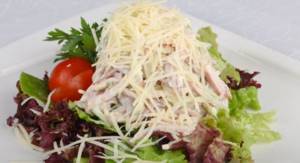
Ingredients:
- 100 g boiled beef;
- 1 small onion;
- 50 g cheese;
- 2 eggs;
- 2 tbsp. vinegar 6% (preferably apple cider vinegar);
- mayonnaise and salt to taste.
Preparation:
- Boil the beef.
- Boil eggs and cool.
- Mix vinegar with water in a ratio of 2:1.
- Cut the onion into thin half rings and pour in vinegar to marinate for 20 minutes.
- Prepare the food: separate the beef into fibers, grate the cheese on a fine grater, and grate the eggs on a coarse grater.
- Place onions, beef, and eggs on a plate in layers. Each one needs to be greased with a little mayonnaise.
- Sprinkle top and sides with grated cheese.
Place the salad in the refrigerator. After 3 hours it is ready.
Marinated squid on the grill
You will love the spicy and unusual taste of seafood.
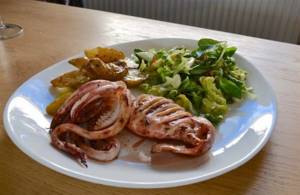
To prepare you will need:
- 250 g squid;
- 1 tbsp. l. lemon or lime juice;
- 25 ml olive oil;
- 50 ml soy sauce;
- 2 small cloves of garlic;
- sweetener to taste;
- 0.5-1 cm of ginger root.
Step by step recipe:
- Wash and clean the carcasses well.
- Chop ginger and garlic.
- For the marinade, mix soy sauce, oil and lemon juice, add ginger, garlic and sweetener.
- Leave the squid in the marinade for 30-50 minutes.
- Grill over coals for 10-15 minutes.
Seafood will be delicious not only immediately after cooking, but also cold.
Creamy lemon-caramel jelly
Why not treat yourself to dessert sometimes even when you're on a diet?
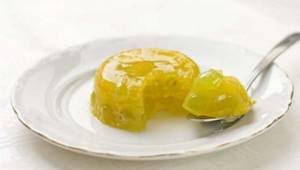
For jelly you need to take:
- 175 g cream (fat content not less than 35%);
- 125 g soft cheese (Ricotta or similar);
- 5 g gelatin;
- 15 g sweetener;
- 1/2 lemon.
Preparation:
- Squeeze lemon juice.
- Add half the sugar substitute and cook until light caramel.
- Heat some cream and dissolve gelatin in it.
- Mix cream, lemon caramel, cheese, gelatin with a mixer, add sweetener to taste.
- Pour into silicone molds.
- Place in the refrigerator until hardened.
After an hour and a half, you can taste the delicate creamy jelly.
How are proteins and fats consumed on a low-carbohydrate diet?
When discussing a low-carbohydrate diet, menu, reviews usually relate to carbohydrates and the rate of their consumption. However, let's not forget that all foods consist of three types of nutrients. How should you consume proteins and fats?
Protein is the building material for your muscles and is also a source of essential amino acids. They are named as such because it is impossible to obtain amino acids from anywhere other than protein. As for fat, the body needs it, but not in huge quantities, and most of it is of plant origin. Vegetable oil does not cause the appearance of cholesterol plaques, but factory-made fatty sausage and mayonnaise easily do. The no-carbohydrate diet for drying differs from the Kremlin’s popular one today, which limits the amount of not only carbohydrates supplied with food, but also fats.
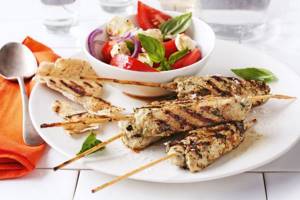
Therefore, it doesn’t matter whether a dry diet is being developed for women or a low-carbohydrate diet for men, the menu will consist of low-fat meat products. For example, the ideal meat product is chicken breast, beef, and fish. Someone may notice that some types of red fish are very fatty - this is true. But, firstly, even the fattest fish will seem simply dietary compared to pork or lamb, and secondly, fish is rich in omega-3 fatty acids, which are incredibly healthy. In addition, the menu for those following the principles of a low-carbohydrate diet will include cottage cheese (with a low percentage of fat content) and an egg.
If you like chops, cutlets, scrambled eggs and bacon, sausages and cheeses, then you will have a hard time on a low-carbohydrate diet for drying - all these products are simply not available.
Rules for quitting the diet
A severe carbohydrate deficit gives quick and high-quality weight loss results.

But an incorrect return to your usual diet can just as quickly return your weight to its original point.
Getting out of a diet is no less important than the process of losing weight itself. Carbohydrates are reintroduced into the diet gradually, increasing the amount consumed by 10 g every week.
Suitable for the first days:
- “safe” cereals;
- quality pasta;
- wholemeal bran bread;
- low carb fruits.
It is important to continue to eat small meals, at least 5 times a day. Fat consumption should be limited.
It is useful to adhere to the “green plate” principle:
- 1/2 serving – vegetables and herbs;
- 1/4 serving – any healthy grains or beans;
- 1/4 serving – foods containing protein (fish, chicken breast).
At the final stage, the carbohydrate content increases to 90-120 g per day. This is the optimal volume when balancing BZHU for the body’s vital functions and maintaining normal weight.
It is better not to stop physical activity. It is not necessary to train intensively in the gym; brisk walking and exercises in the morning are enough.
Drinking regime
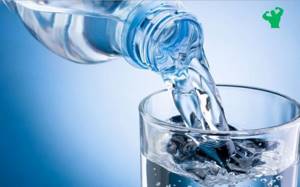
When drying, 80% of the diet is vegetables and fruits. As you know, when taken in large quantities, various problems with the gastrointestinal tract can occur, since they contain a lot of fiber. Metabolism may be inhibited or the digestibility of food may deteriorate. To prevent possible troubles, it is recommended to follow a drinking regime. Depending on the individual characteristics of the body, the volume of liquid may vary, but in general it is worth sticking to 2.5 to 3 liters of clean water per day.
Experts also encourage the enrichment of table water with mineral salts using the drug Regidron. This powder product is diluted in water, the dosage is used three times less than indicated in the official instructions for the drug.
Who is this diet contraindicated for?
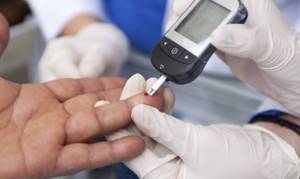
A carbohydrate-free method of losing weight in combination with sports is prohibited for people with the following health problems:
- dystrophy, lack of muscle mass;
- diabetes;
- disorders of the nervous system;
- infectious diseases;
- disorders of the gastrointestinal tract;
- liver and kidney diseases;
- low immunity.
The path to an ideal body lies through a special diet and intense physical activity, so before drying you need to consult a doctor.
attuale.ru
How the body works when you give up carbohydrates
With a sharp change in the usual diet, certain chemical reactions occur in the human body. It is worth noting that with carbohydrate-free drying, the calorie content of foods is only a secondary factor. What matters is what you eat. A sharp decrease in carbohydrates leads to the fact that the body has to convert other reserves into energy, in this case they are fat deposits and muscles. Of course, it is easier for the body to get rid of muscle than fat. Muscles are a foreign body for our body and do not bring any benefit. For this reason, in addition to drying, it is necessary to regularly train so that in the process of a kind of weight loss you do not lose muscle mass. In this case, the body begins to process fat reserves.
It is important! Physical activity is important to achieve the desired effect. The training plan is individual for everyone. To compile it, it is recommended to contact specialists.

